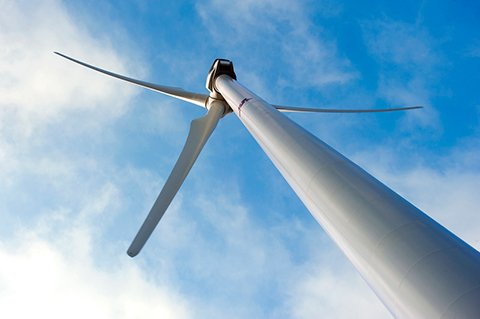Researchers develop advanced wind turbine control algorithm

The St. Anthony Falls Laboratory (SAFL) is currently investigating technologies for improving wind turbine/wind farm efficiency that can help reduce the cost of wind energy. Funded by Xcel Energy and led by UMN Adjunct Professor and former SAFL director Fotis Sotiropoulos, the academic and industrial team for this project consists of University of Minnesota researchers, Mikhail Energy Consulting, and Barr Engineering. The overall project objective is to develop an industry-leading simulation tool for increasing power generation and reducing turbine structural loads and corresponding maintenance costs on existing and newly planned wind farms. Recently, the researchers achieved a significant milestone - successfully designing and implementing an advanced turbine control algorithm on the 2.5 MW Eolos wind turbine, a research wind turbine located in Rosemount, Minnesota.
Peter Seiler, Assistant Professor in Aerospace Engineering and Mechanics at the University of Minnesota, and his postdoctoral associate Daniel Ossmann have designed an advanced algorithm for pitching, i.e. rotating, the three blades on the Eolos Clipper Liberty C96 2.5 MW wind turbine as they travel around the turbine hub. As wind speeds increase with distance from the Earth’s surface, the turbine blades experience varying loads as they rotate, with greater loads and torque experienced as the blades approach the apex of their rotation. This algorithm, called the individual pitch control (IPC) controller, reduces the loads on the turbine blades and nacelle (turbine hub casting) by enabling the blades to change their pitch as they rotate. This design improves upon previous algorithms by explicitly accounting for couplings that are neglected by existing IPC algorithms. Using high-fidelity structural simulations, this controller successfully decreased blade, nacelle and drivetrain loads by more than thirty percent.
The next stage of the project includes testing and validating the simulation results by implementing the IPC controller on the Eolos Wind Turbine. Engineers from Mikhail Energy Consulting, including Amir Mikhail, Alan Danker and Sandeep Gupta, as well as SAFL researchers Chris Milliren and Matt Lueker collaborated to develop the software and hardware required to implement the IPC controller on the turbine. Shu Wang, another post-doctoral researcher working with Professor Seiler, also made improvements to the algorithm during this implementation phase.
Currently, preliminary data has been collected from the turbine for analysis and the team is working to compare the new IPC controller against existing algorithms. If the IPC controller performs as expected, the improvement on the turbine load reduction will eventually lower the maintenance cost of wind farms, bringing more economic benefits to the industry.
In the future work, the IPC controller will be implemented in the Virtual Flow Simulator (VFS-Wind), a high-fidelity CFD (computational fluid dynamics) model for wind-farm turbulence simulations developed by the Sotiropoulos’ research group. The predictive capability of the new version of VFS-Wind will be evaluated against the measurements at the Eolos wind turbine. The capability of the IPC controller for load reduction and performance improvement under complex interactions of turbine wakes will then be evaluated using VFS-Wind simulations for canonical turbine arrays and utility-scale wind farms.
